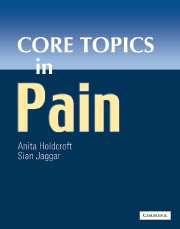Book contents
- Frontmatter
- Contents
- Contributors
- Preface
- Acknowledgements
- Foreword
- General abbreviations
- Basic science abbreviations
- PART 1 BASIC SCIENCE
- PART 2 PAIN ASSESSMENT
- Section 2a Pain measurement
- Section 2b Diagnostic strategies
- PART 3 PAIN IN THE CLINICAL SETTING
- Section 3a Clinical presentations
- Section 3b Pain syndromes
- PART 4 THE ROLE OF EVIDENCE IN PAIN MANAGEMENT
- PART 5 TREATMENT OF PAIN
- Section 5a General Principles
- Section 5b Physical treatments
- Section 5c Pharmacology
- Section 5d Psychosocial
- PART 6 SUMMARIES
- 49 Ethical standards and guidelines in pain management
- 50 What is a clinical guideline?
- Glossary
- Index
50 - What is a clinical guideline?
from PART 6 - SUMMARIES
Published online by Cambridge University Press: 10 December 2009
- Frontmatter
- Contents
- Contributors
- Preface
- Acknowledgements
- Foreword
- General abbreviations
- Basic science abbreviations
- PART 1 BASIC SCIENCE
- PART 2 PAIN ASSESSMENT
- Section 2a Pain measurement
- Section 2b Diagnostic strategies
- PART 3 PAIN IN THE CLINICAL SETTING
- Section 3a Clinical presentations
- Section 3b Pain syndromes
- PART 4 THE ROLE OF EVIDENCE IN PAIN MANAGEMENT
- PART 5 TREATMENT OF PAIN
- Section 5a General Principles
- Section 5b Physical treatments
- Section 5c Pharmacology
- Section 5d Psychosocial
- PART 6 SUMMARIES
- 49 Ethical standards and guidelines in pain management
- 50 What is a clinical guideline?
- Glossary
- Index
Summary
A family of quality control practices, together with the language that describes them has appeared in the National Health Service (NHS) in the last decade. In contrast, professional bodies have developed guidance on practice for many years.
Clinical practice guidelines (as defined by the US Agency for Health Care Policy and Research (AHCPR)) — systematically developed recommendations that assist the practitioner and patient in making decisions about health care for specific circumstances.
Protocols — local adaptations of broad generalised national guidelines. A protocol has detailed operational instructions for local implementation and should be followed regardless of circumstances. However, there are certain circumstances where generic national protocols are used, for example in resuscitation algorithms. Many local units do not use the term protocol because it is too prescriptive, preferring to develop local guidelines.
Policies — the foundation in principle for clinical practice.
Procedures — systems of instructions explaining how to apply policies to patient care.
Performance measures — tools to assess the extent to which the actions of clinicians conform to guidelines and meet standards.
Codes of practice — sets of recommendations concerning the ethical and social context of clinical practice.
Standards — authoritative statements of levels of performance.
Ideal and minimum acceptable standards may be defined, but a more useful working tool is the optimal standard: the best that conscientious practitioners can achieve under normal working conditions.
- Type
- Chapter
- Information
- Core Topics in Pain , pp. 329 - 334Publisher: Cambridge University PressPrint publication year: 2005



